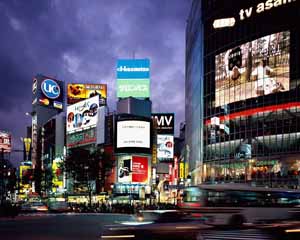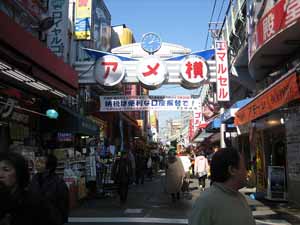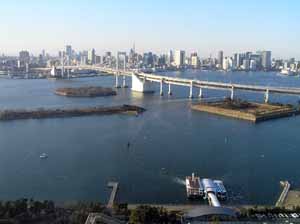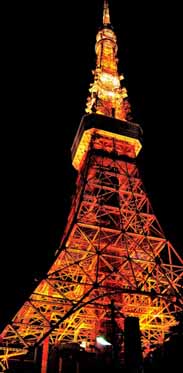
![]()
Index • |
Welcome • |
About
Us • |
21st Century • The Future |
World
Travel • Destinations |
Reviews • Books & Film |
Dreamscapes • Original Fiction |
Opinion
& Lifestyle • News Analysis now |
Film
Space • Movies in depth |
Kid's
Books • Reviews & stories |
Dreamscapes Two • More Original Fiction |
Lifestyles Archive • Politics & Living |
The International Writers Magazine: Japan
• Alice Woolliams
As one of the most populated urban areas in the world, Tokyo is a stunning metropolis that’s packed with people and always bustling with life. Mixing neon signs, cutting edge fashion and giant futuristic TV screens with ancient temples and winding narrow streets, it’s also a city of contrasts.
This huge, sprawling capital of Japan is more like a collection of cities than just one and it would take weeks to get under the skin of each unique district, let alone the whole of Tokyo. But with just two days vacation to spend here, I was determined to make the most of my trip and get a feel for those fascinating contrasts.
Orientation and Confusion
Before I left, I was bombarded by advice on the transport system by friends who’d already made the trip. Instead of being run by the city, Tokyo’s mind-boggling subway network is owned by a number of private companies which use their own exclusive ticketing system for the lines they operate. The friends had an awful lot of stories on the inconvenience and frustration of changing subway trains to get to your destination, only to find your ticket doesn’t work and you have to exit, queue up, pay and then go through the barriers again. I got a similar caution about the sky high prices of taxis – the general consensus was not to use them, even in an emergency.
When we landed at Narita Airport, we headed straight for the Skyliner ticket desk to catch their quick and very futuristic looking train to Ueno (it takes 45 minutes) and get into the city as fast as possible. Although it’s the most expensive way into downtown Tokyo, cost was less of a concern than speed – I only had 48 hours here, after all.
A helpful translator saw us staring at the different ticket options and ended up suggesting the life (or at least hours of confusion) saving option of a ‘Sky Pass’. This helpful package covered the return journey from Narita to Ueno and two days unlimited travel on the metro. Although I had to fork over nearly a quarter of my budget for the weekend, it promised a hassle free way to travel around for the whole duration of the trip and would save money after only a few journeys on the subway. Unfortunately, the pass wasn’t quite as ‘unlimited’ as I was first led to believe, but I only had to figure out the ticketing system twice during the entire trip for extra fares on different company’s lines and that experience was enough to convince me I’d made a wise (and time saving) purchase on such a short vacation.
Finding a place to stay
The subway lines in Tokyo close around midnight, which seems rather early for such a vibrant, buzzing city with excellent nightlife. Bearing that in mind, we decided to find somewhere to stay near the nightlife district of Shibuya so that we would be able to walk back to the hotel after making the most of the evening. Although this was a good idea in theory, most of the reasonably priced hotels and cheap hostels are clustered in the far northern corner of central Tokyo around Ueno – handy for arriving from the airport, not so much after dark. Luckily, I came across the APA Hotel Nishiazabu in Hiroo which was only a 20 minute walk from Shibuya. The price was very reasonable (about £50 per night for a double room) for a city with a reputation as one of the most expensive places in the world, but it was also the smallest room I’ve ever seen – almost comically so. Yet it was clean, comfortable and better equipped than we expected, with toiletries, air con and bottled water.
Day One
When the Skyliner dropped us in Ueno, we got out to stretch our legs and found ourselves in a perfect snapshot of Tokyo – a busy crossing with skyscrapers and the inevitable crowds. Across the road, the wide street narrowed into tiny shopping areas crammed with people, sashimi stalls, vendors selling trinkets via booming loudspeakers and claw machines with bizarre looking prizes. Under the noise of the market was another strange but unmistakable metallic sound – Pachinko machines.Taking in the scene, we wandered under the railway bridge to discover a sushi train restaurant – the perfect first lunch in Japan. Ueno is a happy hunting ground for cheap food so you won’t go hungry here on a budget, and the sushi was also much more affordable than expected in ‘expensive’ Tokyo. Unlike sushi trains back home, this wasn’t a chain or fast food restaurant. All the plates were assembled expertly by a professional chef and kept at the right temperature for maximum taste, rather than chilled to prolong their shelf life. The chef also kept a careful eye on each plate and was quick to discard ones that had been sitting out too long. This fresh, delicious sushi was so far removed from the options in England that it almost seemed wrong to think of them as the same food…
Stuffed full, we retraced our steps to Ueno Park which spreads out behind the station. Here you’ll find the best collection of museums in Tokyo, including the National Museum and Metropolitan Museum of Art, and you can quite happily while away a few hours immersing yourself in Japanese culture. When you’ve had your fill of art and artefacts, step outside to the main square and take a seat by the fountain or at one of the cafés and people watch as crowds cut through the park on their way home.
From Ueno, it’s only a few subway stops to Akihabara. A mecca for electronics fans, this is the place to see Tokyo at its most high tech and wandering through the vast malls will leave you in awe of both modern technology and the way in which Japan embraces it.
With a complete about turn in atmosphere and area, our next stop was Hirajuku. This is one of the older areas in central Tokyo, with narrow streets, interesting architecture and a decidedly European feel – a huge contrast to the concrete jungle of Akihabara. The main draw for this area, however, is the outrageous fashion of the crowds who assemble at the JR station and window shop in the equally outrageous clothes stores. Nicknamed Cos-play-zaku (Costume Play Gang), teenagers deck themselves out in Goth outfits, startling make-up and SM dresses to form a unique spectacle on weekend afternoons. Definitely one for the photo album.
As the sun sets, Shibuya is the only place to be. It’s easy to be overwhelmed as soon as you step off the train – this another busy junction with about a hundred different subway exits, people everywhere and images and neon flashing from giant screens. This noisy, party atmosphere continues into the night, with college students chattering excitedly and wannabe gangsters posing in the streets against hundreds of vintage Cadillacs – another amazing spectacle that’s as unusual and vibrant as the Goth kids of Hirajuku.
We stumbled across a popular izakaya (a pub style restaurant) in a basement and settled in with beer, sake, okonomiyaki and the popular meat skewers to soak up the atmosphere. There’s no shortage of places to eat and drink in Shibuya and they all seem to have one thing in common – they’re loud and busy on a Saturday night.
Day Two
Rousing ourselves bright and early on Sunday (despite the late night walk from Shibuya) to make the most of our last 24 hours in Tokyo, we took the train out to Tokyo Bay. It was interesting to remember that Tokyo is a waterfront city and to get a look at another completely different area of this breathtaking metropolis. From Shimbashi subway station, you can take the new Yurikamome overground line to Odaiba. The train ride itself is well worth the journey out here and you’ll get a stunning aspect over the water and the modern edge of the city as it fades down to the sea. Out in Odaiba, it’s all waterfront resort madness, with amusement parks, entertainment, shopping malls and even a replica of the Statue of Liberty. One of the highlights is the Odeo-Onsen Monogatari, a huge complex with outdoor pools, traditional hot spring baths with natural mineral water piped up from beneath the bay and old fashioned restaurants for a relaxing lunch or cup of tea after your soak.
After this glimpse of the modern consumer obsessions in the vast malls of the bay, we turned back to the old Tokyo with a visit to the Imperial Palace. Although the inside is closed to the public, it’s still a dramatic place to wander around the outskirts and gardens and admire what was once the largest castle in the world.
As the sun sets on your second day, there’s only one place to be to take in the sheer size and scale of the city and its breathtaking skyline – Tokyo Tower. Looking suspiciously like the Eiffel Tower in Paris, the metal structure rises up above the skyscrapers for panoramas over the many districts of Tokyo, where buildings literally stretch in all directions as far as the eye can see. When night falls, thousands of lights light up the sky to change the picture.
Like Shibuya, Roppongi is a popular area after dark and has the same bustling, modern atmosphere of the other district. Here, however, the similarities fade, as Roppongi an older crowd with its expensive hotels and glamorous restaurants. Although local foreigners are rather disparaging about this area as tourist orientated, it is still the best place to find a lavish Japanese meal with the bonus of English menus. You’ll find top class sushi bars and intimate restaurants with crab specialties or sought-after Kobe beef steaks. We decided to spend the rest of our funds (after all, the morning train to the airport was already paid for) on a luxurious seven course meal at a tiny neighbourhood restaurant near Roppongi Hills. And it was all worth the hype – Kobe beef is the most mouth watering steak we’ve ever tasted.Back on the futuristic airport train once more in the morning, 48 hours in Tokyo was over much too soon, but I had more of a sense of what makes this city one of the most fascinating places in the world. Although Japan has embraced designer clothes, electronics, high tech entertainment and city life, the deep roots of an ancient culture are still there under the surface, influencing Tokyo and its people
Alice Woolliams is the Editor for http://www.enjoybedandbreakfast.com/a travel website for accommodation with personality in the UK. Find her on twitter @enjoybnb when she’s not travelling the world.
© Alice Wooliams July 2012
More travel
alice.woolliams@enjoybedandbreakfast.com




